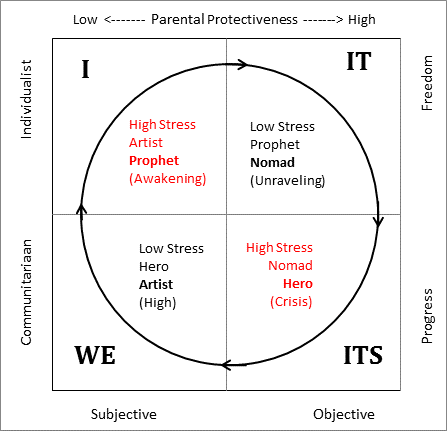Some of you may remember Sean Love (Zarathustra). Sean came up with a system that provided an explanation for how the generation model worked given the fact that generations were longer and lifespans shorter during the early saecula. He started this thread to discuss his multi-modal saeculum model. Recently I have located a free webpage hosting that has no advertising and have put up my saeculum stuff on it, all much revised and (I hope) better thought out:
http://mikebert.neocities.org/home.htm
The first four articles describe long cycles in generation. The American historical cycles article is a general overview of long cycles. The population article describes the evidence for a population-related long cycle and presents a model for it. The war model talks about Quincy Wright’s war cycle and tries to fit this into the Strauss and Howe cycle system. These three articles do not assume a through grounding in the Strauss and Howe cycle theory. The fourth article assumes some knowledge of Strauss and Howe. It makes use of what I have gleaned from Sean’s ideas.
Ten years ago I could not wrap my brain around the multimodal saeculum, went right over my head. More recently after digesting the stuff Chas posted about archetypes I looked at Sean’s multimodal saeculum. He had sent be a document describing his ideas in more detail. I came up with some graphical ways to represent the multimodal saeculum and wrote them up in the Generational model article. The key graphic is this one:

Sean describes each generation in terms of a pair of attributes, each of which can take one of two values, giving four combinations. In the graph the independent/communitarian pair is plotted on the vertical axis and the objective/subjective pair is plotted on the horizontal. Each of the four pairs correspond to one of the four quadrants in the graph and to a particular generation. These four quadrants also correspond to Ken Wilber’s concept of four quadrants or for ways to characterize/study natural or social things that he calls
holons. Based this idea Sean assumed that human being, as holons, had four fundamental perspectives which must be considered to obtain an understanding of the thing being studies. Thus, people come in four fundamental “flavors” or archetypes that correspond to the Wilberian quadrants. Archetypes are a given.
This was key for me. It only became clear to me because of the material Chas has provided over the last year where he looked at Shakespeare’s plays as a way to interpret history in saecular terms. Since the characters in plays fall into archetype, so do the players on the world stage. Just because people can fall into archetypes doesn’t explain generations since we know like-aged people with different archetypes and people of different ages with the same archetype. But Sean’s relating of archetypes to Wilber’s quadrants let me create that graph. I could then see the archetype-generating mechanism in terms of two oscillators (2-stroke cycles) 90 degrees out of phase with each other.
I constructed a model consisting of a pair of two-stroke cycles of period 2L, out of alignment by L. It created the four generations in the correct order. Not explained is where L comes from. That is easy, L comes straight out of the other models I presented. The population model creates a two stroke cycle of feast (good times) and famine (bad times). The war model creates times of prosperity (good) and depression (bad). Both cycles are equal in length to a Kondratiev cycle, which averages about 53 years length. Thus 2L is 53, and so L is about 26 or 27 years, which is exactly as long as the old turnings. This gives L for Sean’s model . Sean says this, but he did not spell out exactly how it all worked. I think I understand now.
Now for the post-1820 period the model I came up with was the paradigm model. The paradigm model uses generations to describe how periodic crises in politics and the economy happen (we are in one now). These periods are defined by the
PE cycle which is really an empirical saeculum*. The paradigms of the model directly correspond to Sean’s attributes. Individualist-Communitarian attributes map into Freedom-Progress paradigms. They are internal and external viewpoints of the same thing. Similarly the subjective-objective attributes map into less protective-more protective parent nurture in S&H’s nurture cycle, and also into spiritual-secular paradigms.
------------------------------------------------------------------------------------------------------------------------
*It’s what the Strauss and Howe turnings look like if you just focus on external events (history) and not take generational biographies into account. Strauss and Howe’s turnings are the same cycle, but viewed from the perspective of generational archetypes and personalities by studying biographical material. The big difference between the dating for PE cycle versus S&H is the Missionary awakening. Strauss and How focus on the fact that prophet archetypes were clearly being born in the 1860’s and 1870’s and that by 1890 it was clearly Nomads being born. The 1886-1908 S&H dating for this awakening reflects this. On the other hand, awakenings are social moments and as such they are periods of sociopolitical change. The progressive era is one such period and the 1896-1919 dating in the PE cycle reflects this. Both are equally valid, they simply reflect different ways of looking at the same thing.

 . I sometimes go and look at those old posts. Some of those discussions were very interesting.
. I sometimes go and look at those old posts. Some of those discussions were very interesting.
